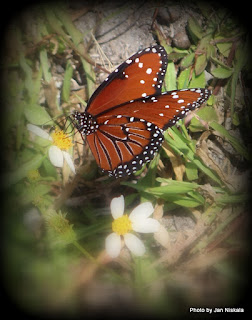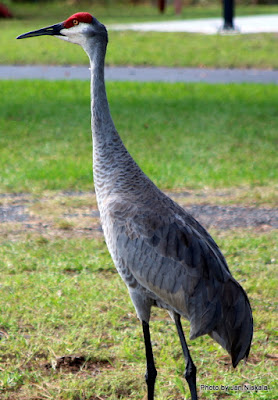This is my first ‘blogette’!
Wow, I know, I’ve been out of pocket for several
weeks!!! We have been busy and I am
going to get everyone caught up as fast as I can.
Okay, so what is a ‘blogette’? It is a really short chapter on my blog.
We stayed at a lovely, small RV park in Florida which had
a good sized pond. Much to everyone’s
delight a family of Sandhill Cranes also chose to live at this pond as well.
The Florida Sandhill
crane is far less common, with some 5,000 remaining. They are most threatened
by habitat destruction. In Florida, they are protected by high monetary penalty.
Sandhill cranes raise one brood per
year
and are monogamous breeders. In non- migrating
populations the
laying
of eggs begins between December and August. In migratory populations, laying of eggs usually begins in
April or May.
Both members of a breeding pair build the nest using plant material from the surrounding area. Nest sites are usually marshes, bogs, or swales, though occasionally on dry land. Females lay one to three oval, dull brown eggs with reddish markings. Both parents incubate the eggs for about 30 days. The chicks hatch covered in down, with their eyes open, and able to leave the nest and follow their parents within a day. The parents brood the chicks for up to three weeks after hatching, feeding them intensively for the first few weeks, then gradually less frequently until they reach independence at 9 to 10 months old. Together, they forage for seeds and roots, crop plants such as corn and peanuts, insects, snakes, frogs and occasionally young birds or small mammals. Cranes are quite omnivorous feeding on seeds, grain, berries, insects, earthworms, mice, small birds, snakes, lizards, frogs, crayfish, but do not "fish" like herons.
A baby Sandhill crane is weighed at White Oak Conservation.
After leaving their parents, the chicks form nomadic flocks with other juveniles and nonbreeders. They remain in these flocks until they form breeding pairs at between two and seven years old. Sandhill cranes are fairly social birds that usually live in pairs or family groups through the year. During migration and winter unrelated cranes come together to form "survival groups" that forage and roost together. Such groups often congregate at migration and winter sites sometimes in the thousands. Cranes live longer than most birds some living into their twenties. Here are some photos I was able to get of our little family of Sandhill Cranes.
Both members of a breeding pair build the nest using plant material from the surrounding area. Nest sites are usually marshes, bogs, or swales, though occasionally on dry land. Females lay one to three oval, dull brown eggs with reddish markings. Both parents incubate the eggs for about 30 days. The chicks hatch covered in down, with their eyes open, and able to leave the nest and follow their parents within a day. The parents brood the chicks for up to three weeks after hatching, feeding them intensively for the first few weeks, then gradually less frequently until they reach independence at 9 to 10 months old. Together, they forage for seeds and roots, crop plants such as corn and peanuts, insects, snakes, frogs and occasionally young birds or small mammals. Cranes are quite omnivorous feeding on seeds, grain, berries, insects, earthworms, mice, small birds, snakes, lizards, frogs, crayfish, but do not "fish" like herons.
A baby Sandhill crane is weighed at White Oak Conservation.
After leaving their parents, the chicks form nomadic flocks with other juveniles and nonbreeders. They remain in these flocks until they form breeding pairs at between two and seven years old. Sandhill cranes are fairly social birds that usually live in pairs or family groups through the year. During migration and winter unrelated cranes come together to form "survival groups" that forage and roost together. Such groups often congregate at migration and winter sites sometimes in the thousands. Cranes live longer than most birds some living into their twenties. Here are some photos I was able to get of our little family of Sandhill Cranes.
Interesting right? Hope you enjoyed them.
Oh, and I couldn't pass up this hungry butterfly now could I?




















2 comments:
Loved it!
We have Sandhill Cranes close to home, about fifteen miles to the south west in an area known as Goose Pond.
Post a Comment